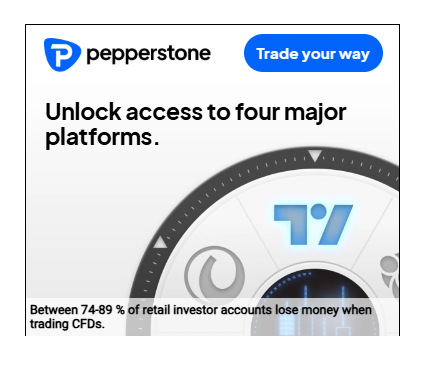
3 minute read
Pepperstone Vs Oanda 2025: Compared - which is better broker?
from Pepperstone compare
by Jone Eva
Both Pepperstone and OANDA are established forex and CFD brokers with global reach in 2025. Yet they target slightly different trader profiles. This comparison examines regulation, account types, pricing, platforms, execution, leverage, funding, education, and support to help you choose the broker that best suits your needs.
Open your Pepperstone account today

1. Regulation & Client Protection
Pepperstone is regulated by ASIC (Australia), FCA (UK), CySEC (EU), DFSA (Dubai), and CMA (Kenya). It offers segregated client funds, negative‑balance protection, and compensation schemes up to £85,000 (FSCS) or €20,000 (ICF).
OANDA is regulated by multiple top authorities: CFTC & NFA (USA), FCA (UK), IIROC (Canada), ASIC (Australia), MAS (Singapore), and others. OANDA provides segregated funds, negative‑balance protection, and U.S. clients benefit from NFA oversight.
Edge: OANDA’s MAS and IIROC licences give extra confidence for Asian and Canadian traders; Pepperstone’s DFSA and Kenyan licences serve MENA/Africa.
2. Account Types & Minimum Deposits
Pepperstone offers Standard (zero min deposit), Razor (raw spread + commission, rec. $200), Islamic swap‑free, and VIP (from $50k).
OANDA provides a single “Core” account (no minimum deposit), and a Premium account (for high-volume clients) with volume-based pricing. No separate raw‑spread tier; spreads widen to include the broker’s margin.
Edge: Pepperstone’s Razor account gives transparent raw spreads; OANDA’s single account is simpler with no deposit barrier.
3. Spreads & Pricing
Pepperstone Standard: EUR/USD ~1.0 pip; Razor: from 0.0 pips + $7 commission round‑turn.
OANDA Core: EUR/USD spreads average ~1.2 pips; Premium: spreads from ~0.8 pips with volume discounts, no explicit commission.
Edge: Pepperstone Razor delivers tighter all‑in costs for active traders; OANDA’s volume tiers benefit very high‑volume institutional clients.

4. Trading Platforms & Tools
Pepperstone supports MT4, MT5, cTrader, TradingView integration, Autochartist, Trading Central, free VPS.
OANDA offers its proprietary fxTrade platform (web, desktop, mobile), MT4, TradingView, plus in‑platform economic charts and news.
Edge: Pepperstone’s cTrader and third‑party signal integrations appeal to technical traders; OANDA’s fxTrade platform is highly polished for fundamentals and charting novices.
5. Execution Quality & Liquidity
Both use ECN/STP models with no dealing desk. Both report sub‑30 ms latency and minimal slippage.
Pepperstone has additional liquidity pools in Dubai/Kenya; OANDA leverages large bank networks and internal matching in the U.S.
Edge: Execution performance is comparable; choose based on your region’s server proximity.
6. Leverage & Risk Controls
Pepperstone: up to 1:500 non‑ESMA, 1:30 ESMA.
OANDA: up to 1:50 (USA), 1:400 (non‑US/ESMA), 1:30 (EU/UK).
Both offer guaranteed stop‑loss orders and negative‑balance protection.
Edge: Pepperstone allows slightly higher leverage outside the US; OANDA adheres to stricter US caps.
7. Funding & Withdrawal
Both support bank transfers, cards, Skrill, Neteller, and some local methods. OANDA also supports PayPal in select regions. Processing times and no‑fee policies are similar.
Edge: OANDA’s PayPal support can be convenient for some.
8. Education & Research
Pepperstone: Trader’s Hub, webinars, Autochartist, Trading Central.
OANDA: extensive economic analysis, webinars, daily market commentary, research from Dow Jones Newswires.
Edge: OANDA’s fundamental research is stronger; Pepperstone’s technical signal suite excels for chartists.
9. Customer Support
Both offer 24/5 support via live chat, email, and phone. Response times are under two minutes on live chat for each.
Edge: Tie.
Which Broker Is Better for You?
Beginners & Fundamentals Traders: OANDA’s fxTrade, no‑min deposit, and strong economic research.
Scalpers & Technical Traders: Pepperstone Razor with cTrader, raw spreads, and third‑party signals.
High‑Volume Institutional: OANDA Premium volume discounts.
MENA/Africa Traders: Pepperstone’s DFSA/Kenya licences.
U.S. Traders: OANDA’s CFTC/NFA regulation (Pepperstone does not serve U.S. residents).
Conclusion: Both brokers excel in different niches. Choose Pepperstone for raw‑spread execution and technical tools; choose OANDA for integrated fundamental research and U.S. regulatory coverage.
Open your Pepperstone account now and trade under the conditions that suit you best!










